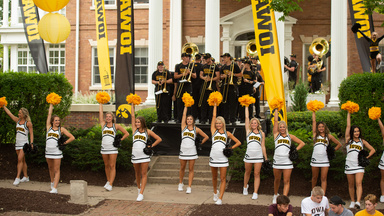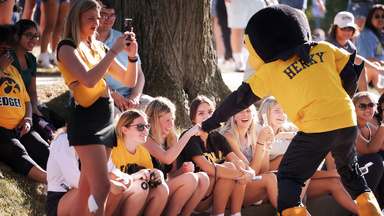Convocation brings our community together in a special way and at a special place- starting the school year off before the Old Capitol in the heart of our campus.
Learn More
Start learning the traditional Iowa Fight Song, Alma Mater Iowa, and the Old Gold Hymn.
Traditional Songs
As a Hawkeye, you join a proud tradition of innovators, leaders, and explorers. Read on to learn about a few Iowa inventions and some of the alumni who've paved the way for you and your classmates.
For more than 150 years, the Old Capitol has represented the pioneering spirit of Iowa and the University of Iowa. The last capitol of the Iowa territory, it served as Iowa’s first state capitol from 1846 to 1857. When state government moved to Des Moines in 1857, Old Capitol became the university’s first building and the founding place of many departments.
In 1976, Old Capitol became a National Historic Landmark and public museum. After four years of restoration following a devastating 2001 fire, Old Capitol Museum reopened in May 2006 as a vital cultural and educational resource for more than 30,000 visitors and researchers each year.
The Pentacrest is the heart of the University of Iowa campus, and for years was the campus. The four buildings surrounding Old Capitol (Schaeffer Hall, Jessup Hall, Macbride Hall, and MacLean Hall) are named after former university presidents.
In the early 1920s, the site was called the “Five-Spot,” until the Daily Iowan held a naming contest, which produced “Pentacrest” as its winner.
Over the years, the Pentacrest has hosted traditional ceremonies like Convocation to open the school year and commencement in the spring. It’s been a site for pep rallies and protests, festivals and concerts, studying and socializing.
At a senior class meeting in spring of 1887, student Marvin H. Dey suggested the university was behind the times in failing to adopt school colors and a school song. A committee subsequently recommended gold as a school color, and students approved the choice at a mass meeting. A woman present at the meeting took an old gold ribbon from her hair, tore it into pieces, and passed them around as samples.
By 1891, gold had been accepted as Iowa’s color, but there was some question as to the shade—old gold or simply gold? A June 1894 election made it official: old gold it was and remains still today.
It wasn’t until 1905 that the UI adopted an official song. University president George E. MacLean sponsored a contest for lyrics, offering a $20 prize. The winner from 17 submissions, penned by senior John Carl Parish, became the “Old Gold Hymn,” sung by audiences for many years at the conclusion of commencement.
The state of Iowa’s nickname is the Hawkeye State, and the University of Iowa borrowed its athletic nickname from the state many years ago. It is not clear how Iowans became Hawkeyes, but the nickname was first recorded in 1859. Some people believe that a Burlington judge, David Rorer, suggested the nickname based on a character in The Last of the Mohicans by James Fenimore Cooper.
The name also got support from James G. Edwards of Fort Madison. Edwards, editor of the Fort Madison Patriot, moved his newspaper to Burlington, Iowa, and renamed it the Hawk-Eye and Iowa Patriot. The campaign to popularize the name was rewarded when territorial officials gave their formal approval in 1838.
The Hawkeye nickname gained a tangible symbol in 1948 when a cartoon character, later to be named Herky the Hawk, was hatched.
The creator was Richard Spencer III, instructor of journalism. The impish hawk was an immediate hit. He acquired a name through a statewide contest. Herky is short for Hercules, the strong man in Greek mythology.
During a football game in 1959, Herky came to life as the Iowa mascot with a black leather head and gold felt feathers. Since then, Herky has become a familiar figure at events of all types on the UI campus.
When Hayden Fry took over the Iowa football program in 1979, he decided he wanted a new logo for the team’s helmet, something distinctive. He worked with a local graphic designer who sketched his first draft on a napkin—the polished version became the Tiger Hawk. Thirty-three years later, the Tiger Hawk is one of the most recognizable logos in college sports and an iconic symbol for Hawkeye fans.